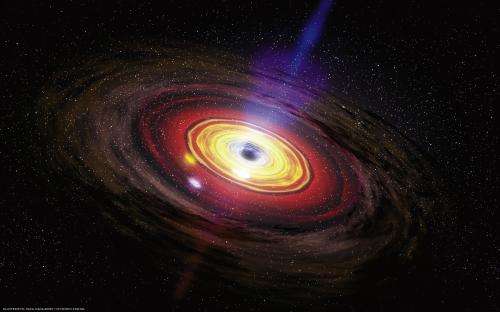Dating our galaxy's dormant volcano

(Phys.org) —A dormant volcano—a supermassive black hole—lies at the heart of our galaxy. Fresh evidence suggests that it last erupted two million years ago.
Astronomers have long suspected such an outburst occurred, but this is the first time they've been able to date it.
The evidence comes from a lacy filament of gas, mostly hydrogen, called the Magellanic Stream. This trails behind our galaxy's two small companion galaxies, the Large and Small Magellanic Clouds.
"For twenty years we've seen this odd glow from the Magellanic Stream," said Professor Joss Bland-Hawthorn, an ARC Federation Fellow at the University of Sydney, Australia, and a Fellow at the Australian Astronomical Observatory, who led a team studying this problem.
"We didn't understand the cause. Then suddenly we realized it must be the mark, the fossil record, of a huge outburst of energy from the center of our galaxy."
"It's been long suspected that our galactic center might have sporadically flared up in the past. These observations are a highly suggestive 'smoking gun'," said Martin Rees, Astronomer Royal, who was one of the first people to suggest that black holes generate the power seen coming from quasars and galaxies with 'active' centers.
The team gives its arguments in a paper accepted for publication in The Astrophysical Journal. Professor Bland-Hawthorn will speak about the work at the Galaxy Zoo meeting in Sydney, Australia, on 24 September.
The galaxy's supermassive black hole has been known for decades. It's orbited by a swarm of stars whose paths let us measure the black hole's mass: four million times the mass of the Sun.
The region around the black hole, called Sagittarius A* ["A-star"], pours out radio waves, infrared, X-rays and gamma rays.
Flickers of radiation rise up when small clouds of gas fall onto the hot disk of matter that swirls around the black hole.
But evidence has been building of a real cataclysm in the past. Infrared and X-ray satellites have seen a powerful 'wind' (outflow) of material from this central region. Antimatter boiling out has left its signature. And there are the 'Fermi bubbles'—two huge hot bubbles of gas billowing out from the galactic center, seen in gamma-rays and radio waves.
"All this points to a huge explosion at the center of our galaxy," said team member Dr. Philip Maloney of the University of Colorado in Boulder, USA. "What astronomers call a Seyfert flare."
Scientists studying the galactic center came together at a workshop at Stanford University in California earlier this year.
While at the workshop, Professor Bland-Hawthorn realized the Stream could be holding the memory of the galactic center's past.
Struck by the fiery breath of Sagittarius A*, the Stream is emitting light, much as particles from the Sun hit our atmosphere and trigger the colored glows of the aurorae—the Northern and Southern Lights.
In the Stream, ultraviolet light splits hydrogen atoms into protons and electrons. When those components recombine, the electrons give off 'H-alpha' emission—a specific wavelength of light.
The brightest glow in the Stream comes from the region nearest the galactic center.
Geometry, the amount of energy from the original flare from Sagittarius A*, the time the flare would take to travel to the Magellanic Stream, the rate at which the Stream would have cooled over time—"it all fits together, it all adds up," says team member Dr. Greg Madsen of the University of Cambridge in the UK.
The galaxy's stars don't produce enough ultraviolet to account for the glow. Nor could they have in the past, says Professor Bland-Hawthorn. "The galactic center never formed stars at a high enough rate."
Will such an explosion happen again?
"There are lots of stars and gas clouds that could fall onto the hot disk around the black hole," says Professor Bland-Hawthorn.
"There's a gas cloud called G2 that we think will fall in next year. It's small, but we're looking forward to the fireworks!"
More information: J. Bland-Hawthorn, Philip R. Maloney, Ralph S. Sutherland, G. J. Madsen. "Fossil Imprint of a Powerful Flare at the Galactic Center Along the Magellanic Stream." Accepted for publication in The Astrophysical Journal. www.physics.usyd.edu.au/~jbh/s … GC_AGN_MagStr_13.pdf
Journal information: Astrophysical Journal
Provided by Australian Astronomical Observatory




















